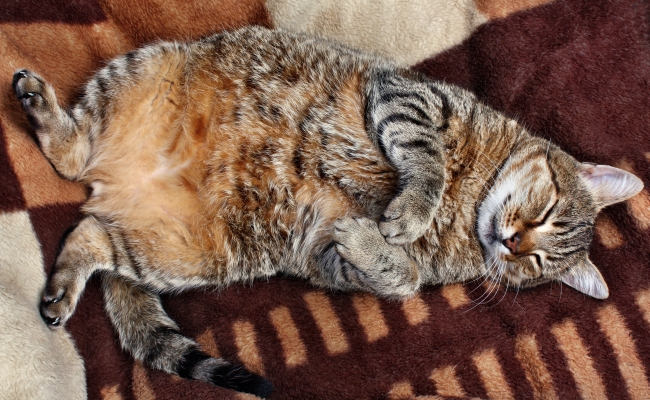
So you are the fortunate owner of a chubby kitty. Whether it is due to your own kitty’s laziness or because of your 5-meal a day plan that your feline’s waist has thickened, we’re not judging, just trying to keep you informed. The first, most important lesson to remember is: FAT IS NOT CUTE. Except on human babies. Maybe pudgy cats and chubby dogs are a little irresistible with all their rolls of fur! But don’t be deceived, the fat is a silent cry for help! Find out the facts below on what you need to know about fat cats and how you can help prevent obesity in your pet:
Facts About Fat Cats
- Notice a resemblance? A little known fact is that cats resemble their owners (because as we’ve shown, people are drawn to animals that resemble themselves. It’s true.) Then it should be no surprised that more than 50% of the domestic cats in America are overweight! The Association for Pet Obesity Prevention did a study last year showing that 58% of American felines are heavier than they should be, which totals to about 55 MILLION cats. Another interesting point: cats have a greater likelihood of being fat than dogs do (probably due to their 12-hour daily naps, dislike of exercise, and occupational lounging). And if you are in better shape than your cat, try not to live vicariously through his calorie consumption but feeding him treats all day.
- Weight varies by breed. Healthy pet cats should bear a moderate weight reflective of their breed, so don’t become militant with the scale numbers, as these are not always comparable for each kind of cat. For example, Maine Coon cats are one of the bigger breeds, meaning that a 20-pounder might be perfectly normal, while a 20-pound Singapura (usually weighing no more than 6-8 lbs) would be nearing death’s doorstep.
- Start budgeting for veterinary bills. If you have a fat cat, he may face serious potential health problems such as:
– Diabetes
– Liver disease
– Skin irritations
– Inflammatory bowels
– Arthritis, and inflamed joint diseases. - Carb-overload is a real problem. You aren’t the only one who has to look out for foods containing white flour, processed sugars, starches and other kinds of bread products. Cats put on weight often because of the high content of carbohydrates in their food bowls. Read the ingredients (looking out for these sly marketing schemes) on a package before you choose your kitty kibbles.
- Healthy cats prefer a wild time. (Not Wild Thyme, last time we checked cats that like eating plants are not as into herbs. More like basic, uninteresting green leaves or your new potted flower.) But in the nature, wild cats would consume mice, rats, voles, birds, etc. all of which are high in protein, and only have about 30-40 carbs per serving. (One mouse is considered a serving of food. Hopefully by no human culture.) Help the kitten lose the pounds by feeding them a more natural kind of diet, such as one based on their archetypal nutritional needs.
- Fat cats like to graze. That is not a good thing. Grazing is what cows do to become someone else’s dinner. Ever heard of the term “fatten him up?” like what the witch in Hansel & Gretel did to the children? She let them graze on her edible candy house all day, hoping to turn them into tasting morsels to eat. Gross! Don’t leave your cat food out all day for him to nibble on just whenever he pleases. He might be eating out of boredom and getting bigger by the hour! Instead put the food out at regular times yourself, or using a time meal feeder, and your kitty-cat will learn the drill (while losing his fat).
- You can trick your cat into becoming fit. While joining you on a jog is hardly something a papered puddy-tat would do, you can still get him to burn calories. Cats love games. Find some interactive toys to inspire your cat to get into action. A remote control mouse, a laser pointer, a scratch pad, a carpeted cat tree or even a bouncy ball might keep him physically engaged. He won’t even realize that he exerting himself, he’ll be having so much fun!
- Cut the cream. People have given felines bowls of milk for centuries. We know, but people didn’t brush their teeth back then either, so society has stepped up several hundred notches. Milk is not good for cats since they don’t process lactose well. So don’t give the kitty any more cream or let them lick your plate for scraps where there are butter or rich creamy sauces that could beef them up.
- CarboHYDRATES are bad, but HYDRATING is a must! Cats have a much higher tendency towards dehydration than dogs. While leaving food out all day is unadvisable, leave your cat’s water bowl out all day to encourage him to stay refreshed with some H2O. If you want to lend a healthy hand, switch to wet cat food which offers a massive increase of hydration, since most are 85% water! For this reason, canned foods (with plenty of real-animal protein) are better for your famished feline.
- Make a change by getting on a plan. Don’t go extreme by forcing your kitty starve (since he might get hepatic lipdosis disease and DIE horribly of food-withdrawals in front of your very eyes), but moderate his portions regularly, and measure his weight. Take it slow, and help wean your cat out of his roly-poly lifestyle.
Still not sure how this applies to you? Here is the easiest way to find out if your cat is fat.

